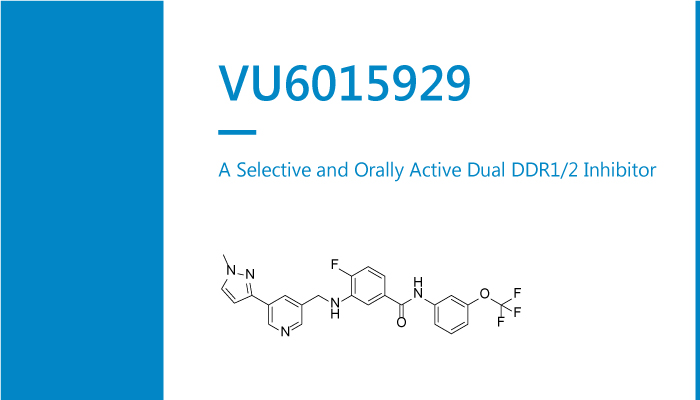Receptor tyrosine kinases are a large family of cell surface receptors responsible for regulating cellular proliferation, differentiation, survival, metabolism, and life cycle. Discoidin domain receptors 1 and 2 (DDR1 and DDR2) are receptor tyrosine kinases. DDRs widely express in developing organs. DDR1 expression is predominant in epithelial cells; while DDR2 is most commonly found in cells of mesenchymal origin. Blocking DDR1 activity with a small molecule inhibitor is an attractive option to treat DDR1 related progressions of fibrotic disease. In this study, researchers report the discovery of VU6015929. Especially, biochemical activity of RAF709 is a potent and selective dual DDR1/2 inhibitor.

VU6015929 is a new dual DDR1/2 inhibitor with improved binding and cell-based potency. Typically, VU6015929 enhances physiochemical and DMPK properties and clean kinome profile to serve as a new in vitro and in vivo tool compound. Correspondingly, VU6015929 displays low cytotoxicity, good kinome selectivity, and possessing an acceptable in vitro DMPK profile with a good rodent in vivo pharmacokinetics. Consistently, VU6015929 potently blocks collagen-induced DDR1 activation and collagen-IV production, suggesting DDR1 inhibition as an exciting target for anti-fibrotic therapy. Moreover, VU6015929 potently inhibits collagen IV production. As a result, further validating a role for DDR1 as the pro-fibrotic receptor.
VU6015929 potently inhibits collagen-induced DDR1 phosphorylation in cells. In addition, VU6015929 significantly inhibits collagen IV production. Furthermore, researchers evaluated VU6015929 in a rat. VU6015929 (IV 0.5 mg/kg or PO 3 mg/kg) displays a good in vitro: in vivo correlation (IVIC), with moderate in vivo clearance, and 3-hour half-life.
In summary, VU6015929 potently inhibits collagen IV production. Therefore, VU6015929 is a selective DDR1/2 inhibitor in anti-fibrotic therapy.